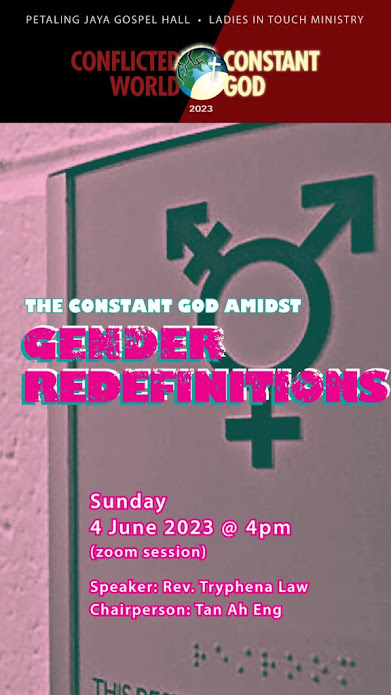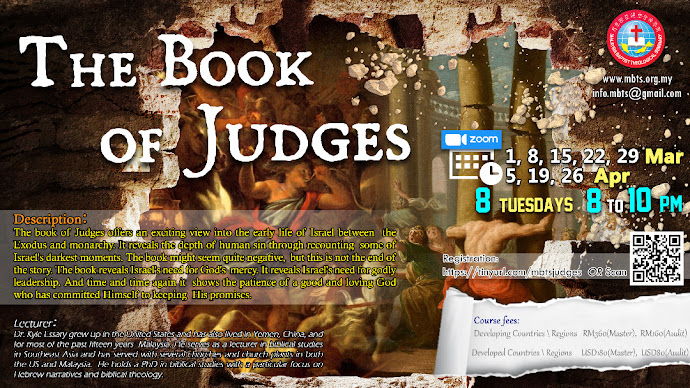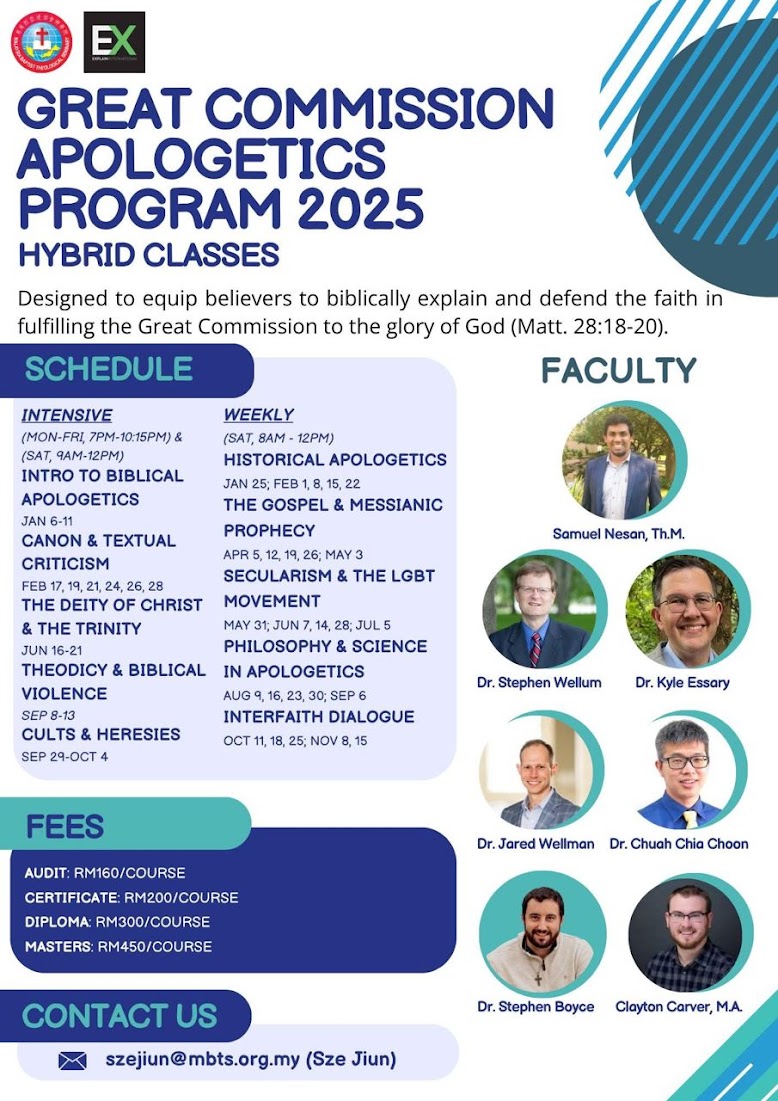Importance of Literary Genre in Interpreting the Book of Revelations
A look at how literary genre affects the interpretation of Book of Revelations
By Stephen Ng
Introduction
In the world of literature, genre
simply means the ‘kind of writing’ (Keener 1993, 825) used in the
literature. Gorman defines it as “a set of texts with common, distinctive
feature” (Gorman 2001, 76) . It determines how a
passage is to be interpreted (Marshall, Travis and Paul 2002, 324) . Therefore, based on
the conventions that an author uses, the genre can be broadly described as
letter, narrative, historical, biography or poem. It is important that the
genre is correctly identified as it would define how a particular passage or
text is to be interpreted.
Revelation is a book of hope. In the
same manner that the Old Testament prophets spoke of a coming Messiah; in
Revelation, we are looking forward to be with Christ in his full glory. When
interpreting Revelation, it is important to have this overall context in mind.
Revelation – A Brief Discussion on its Genre
Describing the book of Revelation, a
definition by John J. Collins from his book, “Introduction: Towards the
Morphology of a Genre” (in Semeia 14, 1979, p 9) is worth quoting:
‘Apocalypse’
is a genre of revelatory literature
with a narrative framework, in which a revelation is mediated by an otherworldly
being to a human recipient, disclosing a transcendent reality which is both
temporal, insofar as it envisages eschatological salvation, and spatial,
insofar as it involves another supernatural world.’ (Marshall, Travis and Paul 2002, 307)
There is no one specific genre for
Revelation. Marshall, et al further describes Revelation as “perhaps the most complex and sophisticated piece of writing the world has ever seen” (Marshall,
Travis and Paul 2002, 305) . Duvall, et al calls
it a “prophetic-apocalyptic letter, especially with its images” (Duvall and Hays
2005, 287) .
All three genres are identified (letter, prophecy, apocalypse) in Revelation. It
is a book with a mixed genre, where each genre is specific to the messages that
it seeks to communicate (Marshall, Travis
and Paul 2002, 325-6) ; therefore, in order to understand the
message in a specific passage in Revelation, it is important to identify the
specific genre that the passage belongs to. The three genres in Revelation are:
Apocalypse: Revelation is first classified as
‘apocalyptic’ literature, based on the Greek word Ἀποκάλυψις (apokalypses) used in Revelation 1:1,
which simply means ‘unveiling’ of the ‘eschatological triumph of Christ’ at the
end of age (Gundry 1981, 343) (Marshall, Travis and Paul
2002, 306) .
Marshall, et al taught that apocalyptic language
encompasses both the language of crisis and the language of imagination; it is
therefore important that one should also understand the context in which the
book was written (Marshall, Travis and Paul 2002, 344) , failing of which it
would be easy for one to misinterpret its original meaning. It is easy to delve
into questions like, “Why ten horns, but only seven heads?” but, according to
Powell, this may not necessarily be the main focus of the author who only attempted
to describe the characteristics of the beast (Powell 2009, 519-520) . What is ‘mystical
and symbolic’ should therefore not be taken materialistically (Eusebius,
Ecclesiastical History, 3.39.11 – 13) (Aune 2010, 632) . Apocalyptic literature should
therefore be taken as a form of
literature that is in a class of its own. It was prevalent during the period
especially from the second century BC until the second or third century AD (Marshall, Travis and Paul 2002, 306) .
Prophecy and
Circulatory Letter: At the same time, the book is
prophetic in nature (it talks about the future (1:3; 22:7, 10, 18–19)). It is also written as a letter (1:4–8; 22:21).
More specifically, it was a circulatory letter written to the seven churches in
Asia Minor. Therefore, scholars such as E.F Harrison has described the book as
“an apocalypse with respect to its contents, a prophecy in its essential spirit
and message, and an epistle in its form” (Lea 1996, 592) . However, Aune
argues that between the apocalypse and prophetic genres, Revelation is closer
to being apocalyptic than prophetic because “like other apocalypses, John’s
Revelation is largely dualistic: there are good folk and there are evil folk”
whereas, “prophecy is more ambiguous: the evil can repent and the good sin.”
In short, Revelation is more than just words from the
mouth of prophets who had divine encounters in a ‘visionary state’ (Aune 2010,
642) . In Revelation, the future was unfolded to John
through dreams and transcendent visions; the visions were interpreted by angels
or other spiritual beings; and John wrote what he saw when he was “transported to
a heavenly or spiritual realm’ (Aune 2010, 642) (Powell 2009, 523) .
Interpreting Revelation 21: 1- 27
Revelation 21 is the ‘finale’ after God had dealt with
sin, Satan and death in earlier chapters (Duvall and Hays
2005, 296-7) .
Written in the form of apocalyptic literature – more specifically its framework
is an ‘autobiographical narrative’ – John describes what he sees and what was
told to him.
Berkhof points out that in order to interpret
Revelation correctly, one has to study the writer’s Old Testament sources of
the language used (Berkhof 2004, 187) . For example, some of the symbolic
language used in this passage is derived from the prophetic books in the Old
Testament, although care must be made that John did not necessarily use the
exact words in its original context. In this case, much of the passage came
from various parts of Isaiah 40-66 and Ezekiel 40-48.
The passage is not written in “mystical and symbolic
language” as claimed by some (Aune 2010, 632) ; therefore, there is no need to
interpret the passage the way the metaphors or symbols (e.g. Babylon, the
beast, 666 and so on in other passages ) are to be interpreted. For example, the
mediator mentioned in this apocalyptic passage is none other than “one of the
seven angels who had the seven bowls full of the seven last plagues”
(21:9). Does the number have a hidden meaning or is it even important to find
out the hidden meaning? Why not the other angels? Noting that the literature is
a first-person narrative, it is likely that John had merely written down what
he saw; therefore, there is no reason to delve into the hidden meaning, as
though there was one. It is however, reasonable to suggest that this
represented the end of all seven last plagues experienced, with the Jewish
belief that the number seven gives a sense of ‘completeness.’
Here we are told that, after all the things came to
pass (referring to the earlier chapters), Revelation ends with a grand finale
and a promise that we look forward to: “a new heaven and a new earth.” In
interpreting the text here, we need to remember the same phrase also appears in
Isaiah 65: 17, “For, behold, I create new heavens and a new earth: and the
former things will not be remembered or come to mind.” By quoting the prophet,
John reiterated the continuity of the Old Testament and the ultimate fulfilment
of Isaiah’s prophecy. God is depicted as the Faithful One, whose promise will surely
come to pass. This was a source of hope for all believers.
God is the “Alpha and the Omega, the beginning and the
end” (21:6). The centrality of God in all things, material or otherwise, in
both space and time, is emphasized again here in this passage. Genesis began
with the story of creation, and in this passage, we are given a glimpse of what
God will do in future. It will be a totally new chapter of a new book, not a
sequel of the old episode. This will not be a reformation or even a
transformation of the old order, but a totally new universe altogether. The new
heaven and the new earth will become the inheritance of the children of God. To
interpret 21:7, one has to refer back to 1 John 5:4 to understand that we
overcome the world by our faith and being born of God.
The New Jerusalem, the Holy City where God dwells with
His people, is described a second time in the same chapter – with further
elaboration in 21:9-27. This clearly shows that John’s emphasis (as in Isaiah
65:18) is on the Holy City of Jerusalem, rather than the new heaven and new
earth. The twelve gates each guarded by an angel represent the twelve tribes of
Israel, while the entire city or the Church is built on twelve foundations,
representing the twelve apostles picked by Jesus. What is important is that the
New Jerusalem – or as Guthrie, et al, puts it, this is referring to the ‘Church’
(Guthrie and
Motyer 1984, 1307)
– would not only include the people of Israel but the Gentiles who were part of
the church. Bird calls this the “remade Jerusalem” which becomes the
‘centrepiece of the new heaven and new earth’ (Bird 2013, 329) . The precious stones
used in the foundations may not necessarily carry any symbolic significance,
but collectively, they simply represent the unfathomable riches of Christ. The
twelve gates are twelve pearls, with one gate for each pearl, while the street
was made of pure gold which appeared more like transparent glass. In all, this
shows the glory of the Holy City, unlike any city in the present world.
We are reminded of Jesus who spoke about himself being
the bridegroom who was to be taken away but here in Revelation, he is depicted
as the bridegroom who will return to claim the bride, whom John describes as
one “beautifully dressed for her husband” (21:2). It is this glorious hope that
we are all exhorted to look forward to. According to Gundry, this is a big
contrast to the other city, the harlot Babylon, which the early church fathers recognised
as imperial Rome; Gundry also suggested that this could mark the beginning of a
millennial kingdom (Gundry 1981, 358) .
The entire passage talks about the eternal (or
permanent) state of a totally new world order, not one that is transformed from
an existing and corrupted world. It is something to be looked forward to by the
saints especially after coming out of the severe persecution and tribulation,
which they themselves would expect to experience. Knowing the eschatology, according to Carson,
et al, would mean that we now understand the past and the present to see how we
fit into the finale. It also clearly shows that our God has a finale in mind,
as He is not only the God of Genesis but also the God of Revelation, the God of
the old world and the God of a brand new world. He is the Alpha and the Omega,
the first and the last, and the beginning and the end. This further reinforces
the eternity of God and what Carson, et al calls ‘a high Christology’ as “Jesus
is constantly portrayed in terms appropriate only to God” (Carson, Moo and Morris 1992,
483) .
Some words worth noting
during interpretation:
Sea: It is difficult to determine whether the word ‘sea’ (21:1) refers
to the literal reading of Isaiah 65:17, where sea is never mentioned; or it
could also have a symbolic link with the evil powers which were revealed in
earlier chapters of Revelation (Aune 2010, 815) (Guthrie and Motyer 1984,
1307) .
Disappearance of the ‘sea’ did not mean the new heaven and the new earth would
not have water anymore (cf 21:7); instead, the sea and the clouds in the sky
would no longer be separated (Genesis 1:6-8).
Tabernacle of
God: The tabernacle of God refers to the ever presence
of God in the midst of His people (Numbers 9:15). Guthrie, et al says the `tabernacle’
here refers more to the Shekinah Glory, rather than the physical tabernacle in
the wilderness that Moses built for the people of Israel (Guthrie and Motyer 1984,
1307) .
Mountain: Based on Ezekiel 40:2, Keener suggests there is a significance to the mountain top (21:15),
saying that “apocalyptic texts sometimes used a mountain reaching to heaven to
provide visibility” (1Enoch 17:2; cf 18:6-8; 24:1-3; 77:4; Mt 4:8) (Keener 1993, 817) . Jerusalem was also
regarded as atop a mountain (epistle of Aristeas 83-84, 105-106; often in the
Old Testament eg. Joel 2:1).
Shape of City: According to Guthrie et al, the Greeks refer the square as a symbol
of perfection (Guthrie and
Motyer 1984, 1308) .
The New Jerusalem, in the shape of a cube (21:16), resembles the Holy of Holies
in the Old Testament temple (1Kings 6:20; Ezekiel 48:35), which was also in the
shape of a cube. The New Jerusalem will always have God’s presence in its
midst. The measurements are not to be taken literally (Keener 1993, 817) .
Measuring Rod: The “measuring rod” comes from Ezekiel 40:3; the measurements of
the city were to produce awe of God’s great promises and thus producing repentance
(Ezekiel 40: 4; 43:10-11) (Keener 1993, 817) instead of being
taken literally.
Heaven: ‘Heaven’ is described by Bird as “the source of the hope we possess
now and the seat of God’s authority.” According to Bird, it is not the final
state because God’s ultimate goal was the merger of heaven and earth as one
with Christ (see Isaiah 65-66). As Bird puts it: “Heaven becomes earthly and
earth becomes heavenly.” (Bird 2013, 329) .
Conclusion
In interpreting Revelation 21, one has to be extra cautious not to read
too much into the details. The context gives it the bigger picture of the
eschatological age to come. It is a message of hope, a vision of the glory of
God in all its magnificence, which we are told to look forward to.
References
Aune, David E., ed. The
Blackwell Companion to the New Testament. Chichester, West Sussex:
Blackwell Publishing Ltd, 2010.
Berkhof, Louis. Introduction to the
New Testament. Grand Rapids, MI: Christian Classics Ethereal Library,
2004.
Bird, Michael F. Evangelical Theology
- A Biblical and Systematic Introduction. Grand Rapids, MI: Zondervan,
2013.
Carson, D. A., Douglas J. Moo, and Leon
Morris. An Introduction to the New Testament. Grand Rapids, MI:
Zondervan Publishing House, 1992.
Duvall, Scott J., and Daniel J. Hays. Grasping
God's Word. 2. Grand Rapids, MI: Zondervan, 2005.
Gundry, Robert H. A Survey of the New
Testament. Vol. 381. Grand Rapids, MI: Zondervan Publishing House , 1981.
Guthrie, D., and J. A. Motyer, . New
Bible Commentary. 3rd Edition. Leicester, England: Inter-Varsity Press, 1984.
Keener, S. Craig. The IVP Bible
Background Commentary (New Testament). Downers Grove, Illinois:
InterVarsity Press, 1993.
Lea, Thomas D. The New Testament - Its
Background and Message. Nashville, TN: Broadman & Holman, 1996.
Marshall, Howard, Stephen Travis, and Ian
Paul. Exploring the New Testament: The Letters and Revelation. Vol.
Two. London: Society for Promoting Christian Knowledge, 2002.
Powell, Mark Allan. Introducing the
New Testament: A Historical, Literary and Theological Survey. Grand
Rapids, MI: Baker Publishing Group, 2009.




Comments
Post a Comment